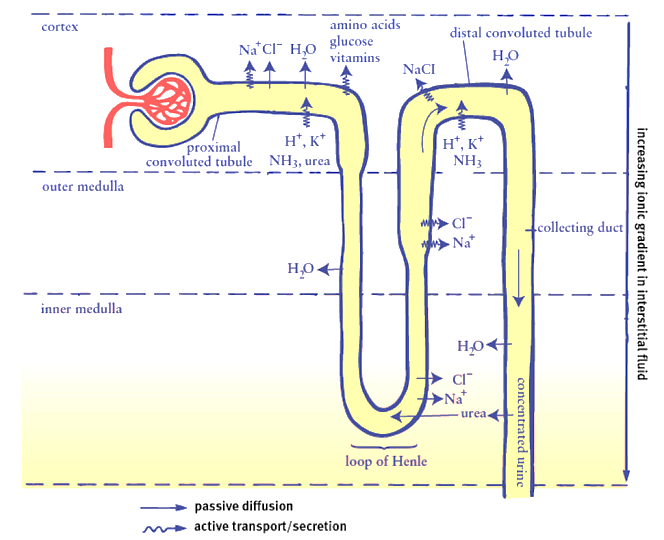
The part of nephron involved in active reabsorption of sodium is
A. Bowman’s capsule
B. Descending limb of Henle’s loop
C. Distal convoluted tubule
D. Proximal convoluted tubule
Answer
449.1k+ views
Hint:Nephron is the structural and functional unit of the kidney. Sodium-ion is a very important mineral that helps to maintain the concentration of blood. One of the major roles is played by sodium ions during urine formation. So, it needs to be reabsorbed in the nephron.
Complete answer:
Sodium reabsorption occurs through the tubules that are present in the nephron – proximal convoluted tubules or PCT and distal convoluted tubules or DCT.
The proximal convoluted tubule or PCT helps in the active reabsorption of sodium ions. It helps to reabsorb the sodium from the urine into the peritubular capillary network and passive flow of water is seen here.
In proximal convoluted tubules, almost 67% sodium ion reabsorption takes place.
In the distal convoluted tubule of the nephron, sodium ion reabsorption occurs but only under hormonal regulation which is a conditional response of the nephron to the environment of the body.
So, the correct answer is option D. Proximal convoluted tubule.
 Fig: Nephron and renal tubular reabsorption across different parts of the nephron
Fig: Nephron and renal tubular reabsorption across different parts of the nephron
Note: Besides sodium ions, potassium ions, calcium ions, bicarbonate ions, chloride ions, water, glucose, urea, uric acid, proteins vitamins, amino acids are also reabsorbed by PCT. In the DCT sodium ion, chloride ion, bicarbonate ion, and water take place under special conditions. In the loop of Henle, a counter-current mechanism of absorption of sodium ions, chloride ions, potassium ions, urea, and water takes place.
Complete answer:
Sodium reabsorption occurs through the tubules that are present in the nephron – proximal convoluted tubules or PCT and distal convoluted tubules or DCT.
The proximal convoluted tubule or PCT helps in the active reabsorption of sodium ions. It helps to reabsorb the sodium from the urine into the peritubular capillary network and passive flow of water is seen here.
In proximal convoluted tubules, almost 67% sodium ion reabsorption takes place.
In the distal convoluted tubule of the nephron, sodium ion reabsorption occurs but only under hormonal regulation which is a conditional response of the nephron to the environment of the body.
So, the correct answer is option D. Proximal convoluted tubule.

Note: Besides sodium ions, potassium ions, calcium ions, bicarbonate ions, chloride ions, water, glucose, urea, uric acid, proteins vitamins, amino acids are also reabsorbed by PCT. In the DCT sodium ion, chloride ion, bicarbonate ion, and water take place under special conditions. In the loop of Henle, a counter-current mechanism of absorption of sodium ions, chloride ions, potassium ions, urea, and water takes place.
Recently Updated Pages
Can anyone list 10 advantages and disadvantages of friction

What are the Components of Financial System?

How do you arrange NH4 + BF3 H2O C2H2 in increasing class 11 chemistry CBSE

Is H mCT and q mCT the same thing If so which is more class 11 chemistry CBSE

What are the possible quantum number for the last outermost class 11 chemistry CBSE

Is C2 paramagnetic or diamagnetic class 11 chemistry CBSE

Trending doubts
10 examples of friction in our daily life

The correct order of melting point of 14th group elements class 11 chemistry CBSE

Difference Between Prokaryotic Cells and Eukaryotic Cells

One Metric ton is equal to kg A 10000 B 1000 C 100 class 11 physics CBSE

What is the specific heat capacity of ice water and class 11 physics CBSE

State and prove Bernoullis theorem class 11 physics CBSE




